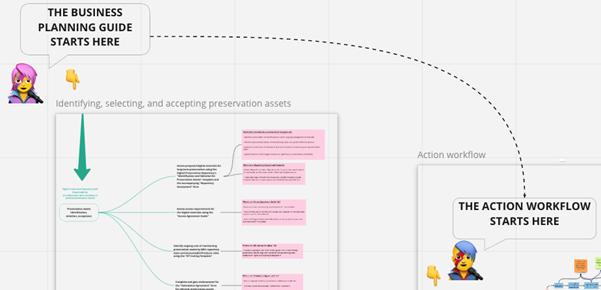Jaye Weatherburn, Program Manager Digital Preservation and Elise Bradshaw, Digital Curation and Archives Specialist work at the University of Melbourne
Supporting digital connections
The theme of this year’s World Digital Preservation Day, “Breaking Down Barriers” connects with some work we have currently underway to realise the University of Melbourne’s 10-year digital preservation strategy. This year in a big effort to build and support connections between the distributed teams contributing to the success of long-term digital preservation at the university, we have been working on a collaborative planning and implementation process for long-term preservation of university records.
This planning has been made even more challenging by the global pandemic, forcing those of us here in Melbourne, Australia, into our 3rd, 4th, 5th, and 6th harsh lockdowns during 2021, working from home with all of the personal and professional challenges this brings. At the time of writing we are still in our 6th lockdown, day 70 – the city with the world record for total number of days in cumulative lockdown (256 and counting). This situation has meant more reliance on digital cross-team planning than ever – you could say digital has been our only hope.
To better connect strategy with implementation on the ground, a business planning process was developed to enable the university’s digital preservationists, archivists, and records managers to scope, identify, and select preservation assets in the "university records" domain, in preparation to implement new workflows for ingesting these materials into our emerging digital preservation repository. This “business planning” process was shared at the DPC’s workflows event back in April 2021.
Unlocking potential
To make the most of having all the experts together for this project, we included all “university records” that might be good candidates for preservation in future in the first attempt to scope the project, even though we were not resourced to preserve them all immediately, and then further refined the scope. Documenting the complete list now puts us in the best position to plan and resource subsequent projects and provides an exciting window into the possible future of digital preservation at the University of Melbourne.
Creating lasting value
This business planning process we’ve been through has enabled us to build relationships across teams, including our records managers, archivists, digital preservationists, while also bringing along for the journey our IT specialists who are learning more about digital preservation every day and how it is different to the traditional understanding of “archiving” in the IT world.
It has enabled us to develop robust and repeatable ingest approaches, through pathways that can be reused we hope as we move on to tackle new domains in scope for the strategy: our cultural collections and research data. We’ve been able to articulate the value in investing in scoping and planning time undertaken by business experts before throwing a technology or tool solution at the problem, gaining endorsement from our executive leadership along the way.
The time consuming and essential documentation work we need to do has also been developed throughout this process. This has included the development of standardised pre-ingest forms to capture necessary information about the content being preserved, as well as the creation of a wiki site containing guidance about the most suitable ingest approaches for different content types and procedural documentation for digital preservation staff and our stakeholders. The wiki creates lasting value for digital preservation at the University of Melbourne by ensuring valuable insights gained during the “university records” planning process will be available for future preservation projects.

